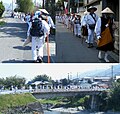Shuin
- Machine translation, like DeepL or Google Translate, is a useful starting point for translations, but translators must revise errors as necessary and confirm that the translation is accurate, rather than simply copy-pasting machine-translated text into the English Wikipedia.
- Consider adding a topic to this template: there are already 3,679 articles in the main category, and specifying
|topic=will aid in categorization. - Do not translate text that appears unreliable or low-quality. If possible, verify the text with references provided in the foreign-language article.
- You must provide copyright attribution in the edit summary accompanying your translation by providing an interlanguage link to the source of your translation. A model attribution edit summary is
Content in this edit is translated from the existing Japanese Wikipedia article at [[:ja:朱印 (神社仏閣)]]; see its history for attribution. - You may also add the template
{{Translated|ja|朱印 (神社仏閣)}}to the talk page. - For more guidance, see Wikipedia:Translation.
 |
| Votive talismans designed for the home |
|---|
| Ofuda, and Jingū taima when from Ise Jingu |
| Votive paper slips applied to the gates of shrines |
| Senjafuda |
| Amulets sold at shrines for luck and protection |
| Omamori |
| Wooden plaques representing prayers and wishes |
| Ema |
| Paper fortunes received by making a small offering |
| O-mikuji |
| Stamps collected at shrines |
| Shuin |
|
A shuin (朱印) is a seal stamp given to worshippers and visitors to Shinto shrines and Buddhist temples in Japan. The seal stamps are often collected in books called shuinchō (朱印帳) that are sold at shrines and temples.[1] Also called "Go-shuin(御朱印)" as an honorific.
The stamps are different from commemorative stamps in that they are made by people who work at the shrines or temples: Shinto Kannushi or Buddhist Hōshi. To create the shuin, the writer presses down one or more large stamps, and then uses black ink to write, in their distinctive calligraphy, the day of the visit, the name of the shrine or temple, as well as sometimes the names of the relevant Kami or Buddhist deities, and other messages.
There are various theories about the origin of shuin, though the strongest is that it was a receipt for a dedicated copied sutra. There are still temples where one cannot receive a shuin without having donated a sutra or money, but the majority of the temples will now accept a small amount of money for a shuin. It usually costs 300 yen,[2] though there are some places that charge up to 1000 yen.[3] At Itsukushima Shrine, there is a sign that asks people to dedicate their feelings.[citation needed]
Special shuinchō (and occasionally hanging scrolls) are available for people who do pilgrimages such as the Kansai Kannon Pilgrimage and the Shikoku Pilgrimage. People who do the Shikoku pilgrimage can also get shuin on the white robes they sometimes wear.
A number of Jōdo Shinshū temples do not offer shuin, in order to discourage the practice of visiting for the sake of only collecting shuin.[4]
Gallery
-
 shuinchō (朱印帳)
shuinchō (朱印帳) -
-
 kasane-in (重ね印)
kasane-in (重ね印) -
 byakue (白衣)
byakue (白衣) -
 miei (御影)
miei (御影) -
 sange (散華)
sange (散華) -
 mangan (満願の証)
mangan (満願の証) -
 A shuin from Dairen-ji (大蓮寺)
A shuin from Dairen-ji (大蓮寺) -
 pilgrimage
pilgrimage
References
- ^ 学研パブリッシング・編 (2011). 開運ご利益東京・下町散歩: スカイツリー周辺・下町・江戶パワースポット. 学研パブリッシング. ISBN 978-4056064513.
- ^ 恵美嘉樹 (2007). 全国「一の宮」徹底ガイド. PHP研究所. ISBN 978-4569669304.
- ^ "専用色紙に朱印もらおう 津で「七福神めぐり」". Chunichi. Archived from the original on 21 February 2013. Retrieved 24 December 2012.
- ^ "朱印をしない理由". Retrieved 24 December 2012.
 | This Buddhism-related article is a stub. You can help Wikipedia by expanding it. |
- v
- t
- e
 | This article related to religion in Japan is a stub. You can help Wikipedia by expanding it. |
- v
- t
- e






















